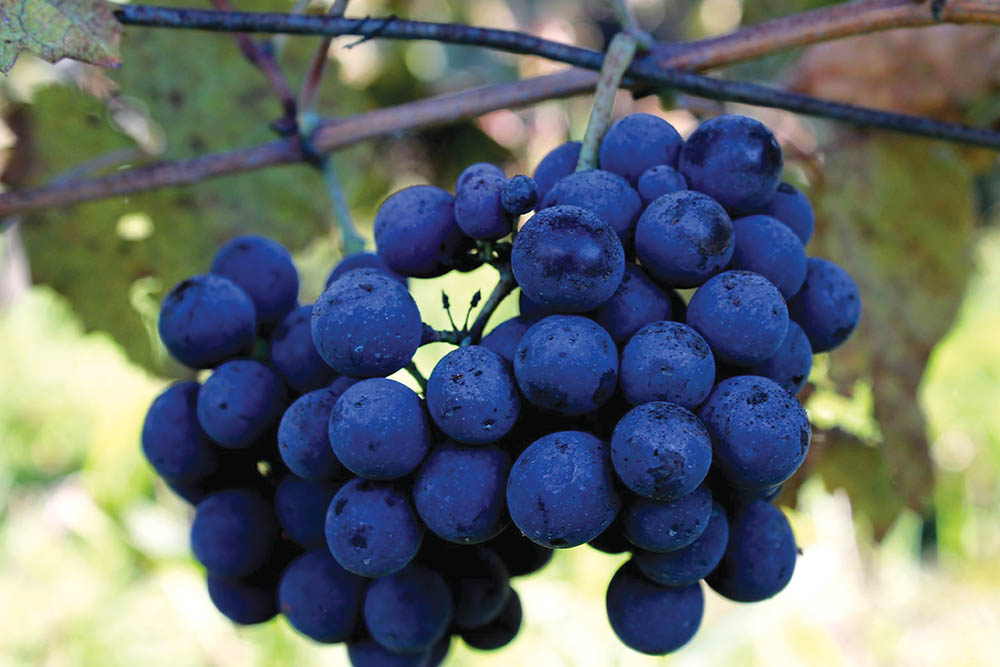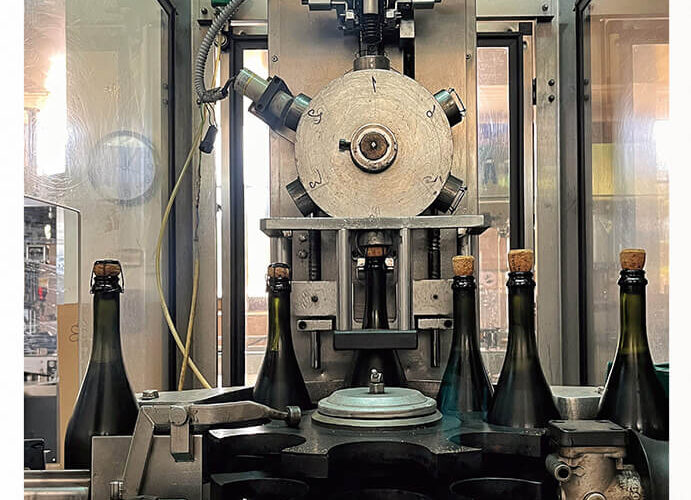| By Irma Mdinaradze. Agriculture Ph.D., Associate professor at Caucasus International University. Chief Specialist, Viticulture analysis and regulation department, LEPL National Wine Agency |

In the realm of viticulture and winemaking, Guria stands out as one of the most noteworthy and traditional regions of Georgia. The remarkability of the wine crafted from the grapes grown in this picturesque part of Georgia is attributed to its exceptional natural conditions, characterised by distinctive mountainous terrain and water-rich river valleys, alongside its warm climate and soil characteristics, as well as the diversity of the varietal composition.
Despite its land scarcity, Guria is distinguished by an abundance of autochthonous grape varieties. Scientific literature sources (N. Ketskhoveli, D. Tabidze, M. Ramishvili, 1960) document 59 grape varieties in the region.
Traditionally, as well as throughout the country, the mentioned varieties are primarily renowned wine grape varieties, notable for their high quality. Historian Ivane Javakhishvili, in his book (Iv. Javakhishvili, 1986), references two works by Gigo Sharashidze, a prominent educator of the early 20th century. Amongst them is “Ampelography of the six best Gurian varieties,” which provides detailed descriptions of the following grape varieties commonly found in Guria at that time: Jani, Mtevandidi, Chkhaveri, Chumuta, Skhilatubani, and Aladasturi.
Currently, the autochthonous grape varieties predominantly prevalent in the viticulture zone of Guria are:

Chkhaveri, (also known as Chkhaveli) is an autochthonous pink grape variety that falls within the category of grape varieties of Guria and is widely cultivated in both the viticulture zones of Guria and Ajara. According to accounts from local winegrowers (Al. Sharashidze from the village of Dablatsikhe and Al. Khundadze from the village of Sachamiaseri) in the past, locals crafted wine from Chkhaveri, which was known for its tenderness, flavour, and moderate alcohol content, even beyond the borders of Guria (N. Ketskhoveli, D. Tabidze, M. Ramishvili, 1960).
This variety is noted for its low to medium yield (5.5-8.0 t/ha) and remarkably late ripening, as grapes in Guria typically ripen from the second half of November. Grape juice from this variety typically has a sugar content of 19.5-21.0%, with its titratable acidity ranging between 8.1-9.6 g/l.
Chkhaveri is a premium quality wine grape variety. Chkhaveri wine crafted using classical (European) methods is distinguished by its stunning hue, often pink or white, along with its delicacy, balance, richness, moderate alcohol content, and unique flavour profile. Additionally, it is effectively used in the production of premium sparkling wines.

Jani (also known as Mari’s grapes or Jani’s grapes) is an autochthonous red grape variety belonging to the group of grape varieties of Guria and is widespread in the viticulture zone of Guria. The renowned agronomist Yakob Mari blended Jani, Skhilatubni, and Mtevandidi to create high-quality wine, famously known as Mari’s wine, which was not only sold in the governorate of Kutaisi but also in Russia and Europe. It is worth noting that he introduced Georgian wine to Europe (Er. Nakashidze, 2018).
This variety is characterised by its below-average yield (3.0-4.0 t/ha) and late ripening, with grapes in Guria typically ripening at the end of October. The grape juice displays a sugar content of 20.9-23.4%, with its titratable acidity ranging from 6.0-9.1 g/l.
Jani is a high-quality, wine grape variety. The wine it yields is noted for its full-bodied nature, moderate alcohol content (11.5-12.1%), and acidity, along with its harmony and exceptional flavour profile. With ageing, it develops a pleasing taste and a rich bouquet.

Aladasturi is an autochthonous red grape variety belonging to the group of grape varieties of Guria and is prevalent in the viticulture zones of Guria and Imereti (kvemo Imereti). According to the ampelography of Georgia (N. Ketskhoveli, D. Tabidze, M. Ramishvili, 1960), Aladasturi has consistently held a prominent position among the red grape varieties cultivated in Guria, renowned as a high yielding wine grape variety. This variety is characterised by its high yield (7.0-10.0 t/ha) and late ripening, typically occurring in late October in Western Georgia. The sugar content of its grape juice can reach up to 19.5-21.5%, with its titratable acidity ranging from 8.5-9.4 g/l.
Aladasturi is a high-quality wine grape variety. Its wine is distinguished by a captivating hue, harmonious balance, distinctive varietal aroma, and a subtle increase in acidity. When the grapes are allowed to ripen further, Aladasturi yields semi-sweet wine of excellent quality.

Mtevandidi (also known as Akido, with Akido in Guria referring to two-clustered branch) is an autochthonous red grape variety belonging to the group of grape varieties of Guria and is sparsely cultivated in the viticulture zone of Guria.
The variety is characterised by its medium yield (6.0-8.0 t/ha) and late ripening. In Chokhatauri and Ozurgeti municipalities, grapes typically ripen from the second half of October. The sugar content in grape juice ranges between 20.0-23.5%, with its titratable acidity falling within 8.5-10.0 g/l. Mtevandidi wine is distinguished by a balanced alcohol-to-acidity ratio, along with notably high flavour profiles.

Skhilatubani (also known as Skhiltaubani, Skhilatobani, Rtskhilatubani, Rtskhilatobani, Tskhilatobani, Tskhrilatobani) is an autochthonous red grape variety belonging to the group of grape varieties of Guria and is sparsely cultivated in the viticulture zone of Guria. The variety is known for its high yield (8.0-9.0 t/ha) and late ripening, typically occurring in the middle of October in Guria. The sugar content of its grape juice ranges from 19.0-20.0%, with its titratable acidity falling within 8.0-9.0 g/l.
Skhilatubani is a high-quality wine grape variety. The wine it produces is characterised by a deep red hue, moderate alcohol content (10.6-11.8%), and acidity, along with a fine body and harmonious profile.

Badagi is an autochthonous pink grape variety, belonging to the group of grape varieties of Guria, and is sparsely cultivated within the viticulture zone of Guria.
The variety is known for its medium yield (7.5-8.0 t/ha) and late ripening. In the conditions of the Ozurgeti municipality, grapes typically ripen at the end of October. The sugar content in its grape juice ranges between 20.5-24.0%, with its titratable acidity falling within 6.5-10.0 g/l.
Badagi is a high-quality wine grape variety. The wine it yields boasts a quince-like colour, a robust body, a balanced ratio of alcohol and acidity, with an alcohol content of 12.7%, and exceptional flavour profile. Notably, the wine’s quality tends to improve with age.

Sakmiela (also known as Sakmevela, Sakmela, Sakmelai) is an autochthonous white grape variety belonging to the group of grape varieties of Guria and is sparsely cultivated in the viticulture zone of Guria. The variety is noted for its high yield (8.5-9.5 t/ha) and early ripening compared to other local varieties. The sugar content of its grape juice ranges between 19.5-20.0%, with its titratable acidity falling within 8.3-8.5 g/l. Sakmiela is a high quality wine grape variety and holds a significant position among white wine grape varieties within the viticulture zone of Guria.

Kamuri Tetri (also known as Tetri Kamura, Kamura, or Kamura grape) is a native white grape variety belonging to the group of grape varieties of Guria, predominantly found in the viticulture zone of Guria.
This variety is characterised by its medium yield (7.0-8.0 t/ha) and late ripening, with its grapes maturing in mid-October. The sugar content of the grape juice falls between 19.0% to 20.0%, while its titratable acidity typically ranges within 8 g/l.
Kamuri is a white, wine and table grape variety, known for its pleasant and vibrant acidity. Its finest qualities were revealed in the suburban zone of Tbilisi, where it has been used to produce premium wine characterised by a balanced alcohol content, full body, and outstanding flavour properties (M. Ramishvili in 1986).

Tsolikouri (also known as Obchuri Tsolikouri, Tsolikauri, Melkos Tsolikouri, Kokhidze Tsolikouri, and Kobakhidze Tsolikouri) is a prominent autochthonous grape variety belonging to the group of grape varieties of Imereti. Its prevalence extends not only throughout the Imereti’s viticulture zone but also across Western Georgia.
This variety is characterised by an average or above-average yield (7-10 t/ha on average), It exhibits a degree of resistance to certain fungal diseases, such as powdery mildew. Ripening occurs late, mainly from the second half of October in Western Georgia. The sugar content in grape juice varies depending on the region, falling within the range of 19.0% to 25.0%, while its titratable acidity typically ranges between 7.5 to 9.5 g/l.
Tsolikouri is a premium wine grape variety and can be used in the production of a diverse range of wines using both the classical (European) and Imeretian winemaking methods. Notably, it contributed to the creation of the original PDO wines: Sviri (together with Tsitska and Krakhuna) and Tvishi.
გურიის მევენახეობის ზონაში გავრცელებეული
ვაზის ადგილობრივი საღვინე ჯიშები
ირმა მდინარაძე
| სოფლის მეურნეობის აკადემიური დოქტორი,
კავკასიის საერთაშორისო უნივერსიტეტის ასოცირებული პროფესორი. სსიპ ღვინის ეროვნული სააგენტოს მევენახეობა-მეღვინეობის ანალიზისა და რეგულირების დეპარტამენტის მთავარი სპეციალისტი. |
მევენახეობა-მეღვინეობის მიმართულებით გურია საქართველოს ერთ-ერთ საინტერესო და ტრადიციულ მხარეს წარმოადგენს. აქ წარმოებული ღვინოების ორიგინალობას უნიკალური ბუნებრივი პირობები, მთაგორიანი და წყალუხვი მდინარეების ხეობებით გამოხატული რელიეფი, დამახასიათებელი თბილი კლიმატი, ნიადაგობრივი თავისებურებები, და რაც მთავარია, ჯიშობრივი მრავალფეროვნება განაპირობებს. მიუხედავად გეოგრაფიული სიმცირისა, გურია გამოირჩევა ვაზის ავტოქთონური ჯიშების სიუხვით. სამეცნიერო ლიტერატურული წყაროების (ნ. კეცხოველი, დ. ტაბიძე, მ. რამიშვილი, 1960) თანახმად, რეგიონში 59 ვაზის ჯიშია აღწერილი. ტრადიციულად, ისე როგორც მთელ ჩვენს ქვეყანაში, აღნიშნული ჯიშები უპირატესად საღვინე მიმართულებისაა და მაღალი ხარისხით გამოირჩევიან.
ისტორიკოს ივანე ჯავახიშვილს თავის წიგნში (ივ. ჯავახიშვილი, 1986) XX საუკუნის დასაწყისის ცნობილი პედაგოგის გიგო შარაშიძის ორი ნაშრომი აქვს მოხსენიებული, მათ შორის, „ექვსი საუკეთესო გურული ჯიშის ამპელოგრაფია“, სადაც საკმაოდ დეტალურად არის აღწერილი იმ დროისთვის გურიაში ყველაზე გავრცელებული შემდეგი ვაზის საღვინე ჯიშები: ჯანი, მტევანდიდი, ჩხავერი, ჭუმუტა, სხილათუბანი და ალადასტური.
დღევანდელი მდგომარეობით, გურიის მევენახეობის ზონაში ძირითადად გავრცელებული ავტოქთონური ვაზის ჯიშებია:
ჩხავერი (სინ.: ჩხაველი) ადგილობრივი ვარდისფერყურძნიანი ვაზის ჯიშია, მიეკუთვნება გურიის ვაზის ჯიშების ჯგუფს და გავრცელებულია გურიისა და აჭარის მევენახეობის ზონებში. ადგილობრივი მევენახეების (ალ. შარაშიძე – სოფ. დაბლაციხიდან, ალ. ხუნდაძე – სოფ. საჭამიასერიდან და სხვები) თანახმად, წარსულში მოსახლეობა ჩხავერისგან ამზადებდა ღვინოს, რომელიც თავისი სინაზით, გემოთი და ალკოჰოლის ნორმალური შემცველობით განთქმული იყო გურიის გარეთაც (ნ. კეცხოველი, დ. ტაბიძე, მ. რამიშვილი, 1960).
ჯიში ხასიათდება საშუალოზე დაბალი ან საშუალო (5,5-8,0 ტ/ჰა) მოსავლიანობით და ძალიან საგვიანო სიმწიფით – გურიაში ყურძენი ნოემბრის მეორე ნახევრიდან მწიფდება. ყურძნის წვენში შაქრიანობა 19,5-21,0 %, ხოლო ტიტრული მჟავიანობა 8,1-9,6 გ/ლ ფარგლებშია.
ჩხავერი მაღალი ხარისხის საღვინე ვაზის ჯიშია. კლასიკური (ევროპული) ტექნოლოგიით დაყენებული ჩხავერის ღვინო ხასიათდება ლამაზი შეფერილობით (ძირითადად ვარდისფერი ან თეთრი), სინაზით, ჰარმონიულობთ, შინაარსით, ალკოჰოლის ნორმალური შემცველობით და მაღალი გემური თვისებებით. წარმატებით გამოიყენება აგრეთვე მაღალი ხარისხის ცქრიალა ღვინოების დასამზადებლად.
ჯანი (სინ.: მარის ყურძენი, ჯანის ყურძენი ადგილობრივი წითლყურძნიანი ვაზის ჯიშია, მიეკუთვნება გურიის ვაზის ჯიშების ჯგუფს და გავრცელებულია გურიის მევენახეობის ზონაში. ცნობილი აგრონომი იაკობ მარი ჯანის, სხილათუბნის და მტევანდიდის შერევით ამზადებდა მაღალი ხარისხის ღვინოს, რომელიც „მარის ღვინის“ სახელწოდებით იყო ცნობილი და იყიდებოდა არა მარტო ქუთაისის გუბერნიაში, არამედ რუსეთსა და ევროპაში. უნდა აღინიშნოს, რომ საქართველოს ღვინო მან გააცნო ევროპას (ერ. ნაკაშიძე, 2018).
ჯიში ხასიათდება საშუალოზე დაბალი მოსავლიანობით (3,0-4,0 ტ/ჰა) და საგვიანო სიმწიფით – გურიაში ყურძენი ოქტომბრის ბოლო რიცხვებში მწიფდება. ყურძნის წვენში შაქრიანობა 20,9-23,4 %, ხოლო ტიტრული მჟავიანობა 6,0-9,1 გ/ლ ფარგლებშია.
ჯანი მაღალი ხარისხის საღვინე ვაზის ჯიშია. ღვინო ხასიათდება დიდი სხეულით, ალკოჰოლისა (11,5-12,1 %) და მჟავიანობის ნორმალური შეფარდებით, ჰარმონიულობით და მაღალი გემური თვისებებით. დაძველებისას ივითარებს სასიამოვნო გემოს და მდიდარ ბუკეტს.
ალადასტური ადგილობრივი წითელყურძნიანი ვაზის ჯიშია, მიეკუთვნება გურიის ვაზის ჯიშების ჯგუფს და გავრცელებული გურიისა და იმერეთის (ქვემო იმერეთი) მევენახეობის ზონებში. საქართველოს ამპელოგრაფიის თანახმად (ნ. კეცხოველი, დ, ტაბიძე, მ. რამიშვილი, 1960) გურიაში გავრცელებულ წითლყურძნიან ვაზის ჯიშებს შორის ალადასტურს ყოველთვის გამორჩეული ადგილი ეკავა, როგორც უხვმოსავლიან საღვინე ვაზის ჯიშს.
ჯიში ხასიათდება უხვმოსავლიანობით (7,0-10,0 ტ/ჰა) და საგვიანო სიმწიფით – დასავლეთ საქართველოში ყურძენი ოქტომბრის ბოლო რიცხვებში მწიფდება. ყურძნის წვენში შაქრიანობა 19,5-21,5 %-მდე, ხოლო ტიტრული მჟავიანობა 8.5 – 9,4 გ/ლ ფარგლებშია.
ალადასტური მაღალი ხარისხის საღვინე ვაზის ჯიშია. ღვინო ხასიათდება ლამაზი შეფერილობით, ჰარმონიულობით, სპეციფიკური ჯიშისთვის დამახასიათებელი არომატით და ოდნავ მომატებული მჟავიანობით. ყურძნის გადამწიფების შემთხვევაში ალადასტურისგან მზადდება კარგი ხარისხის ნახევრადტკბილი ღვინო.
მტევანდიდი (სინ.: აკიდო. აკიდო გურიაში ორმტევნიან რქას ნიშნავს) ადგილობრივი წითელყურძნიანი ვაზის ჯიშია, მიეკუთვნება გურიის ვაზის ჯიშების ჯგუფს და მცირედ არის გავრცელებული გურიის მევენახეობის ზონაში.
ჯიში ხასიათდება საშუალო მოსავლიანობით (6,0-8,0 ტ/ჰა) და საგვიანო სიმწიფით. ჩოხატაურის და ოზურგეთის მუნიციპალიტეტებში ყურძენი ოქტომბრის მეორე ნახევრიდან მწიფდება. ყურძნის წვენში შაქრიანობა 20,0-23,5 %, ხოლო ტიტრული მჟავიანობა – 8,5-10,0 გ/ლ ფარგლებშია. მტევანდიდის ღვინო ხასიათდება ალკოჰოლისა და მჟავიანობის ნორმალური შეფარდებით, საკმაოდ მაღალი გემური მაჩვენებლებით.
სხილათუბანი (სინ.: სხილთაუბანი, სხილათობანი, რცხილათუბანი, რცხილათობანი, ცხილათობანი, ცხრილათობანი) ადგილობრივი წითელყურძნიანი ვაზის ჯიშია, მიეკუთვნება გურიის ვაზის ჯიშების ჯგუფს და მცირედ არის გავრცელებული გურიის მევენახეობის ზონაში. ჯიში ხასიათდება უხვმოსავლიანობით (8,0-9,0 ტ/ჰა) და საგვიანო სიმწიფით – გურიაში ყურძენი ოქტომბრის შუა რიცხვებში მწიფდება. ყურძნის წვენში შაქრიანობა 19,0-20,0 %, ხოლო ტიტრული მჟავიანობა 8,0-9,0 გ/ლ ფარგლებშია.
სხილათუბანი მაღალი ხარისხის საღვინე ვაზის ჯიშია. ღვინო ხასიათდება მუქი წითელი შეფერილობით, ალკოჰოლისა (10,6-11,8 %) და მჟავიანობის ნორმალური შემცველობით, კარგი სხეულით და ჰარმონიულობით.
ბადაგი ადგილობრივი ვარდისფერყურძნიანი ვაზის ჯიშია, მიეკუთვნება გურიის ვაზის ჯიშების ჯგუფს და მცირედ არის გავრცელებული გურიის მევენახეობის ზონაში. ჯიში ხასიათდება საშუალო მოსავლიანობით (7,5-8,0ტ/ჰა) და საგვიანო სიმწიფით – ოზურგეთის მუნიციპალიტეტის პირობებში ყურძენი ოქტომბრის ბოლოს მწიფდება. ყურძნის წვენში შაქრიანობა 20,5-24,0 %, ხოლო ტიტრული მჟავიანობა 6,5-10,0 გ/ლ ფარგლებშია.
ბადაგი მაღალი ხარისხის საღვინე ვაზის ჯიშია. ღვინო ხასიათდება კომშისებური შეფერილობით, კარგი სხეულით, ალკოჰოლისა და მჟავიანობის ნორმალური შეფარდებით, 12,7 % ალკოჰოლის შემცველობით და მაღალი გემური თვისებებით. დაძველებისას ღვინის ხარისხი უმჯობესდება.
საკმიელა (სინ.: საკმეველა, საკმელა, საკმელაი) ადგილობრივი თეთრყურძნიანი ვაზის ჯიშია, მიეკუთვნება გურიის ვაზის ჯიშების ჯგუფს და მცირედ არის გავრცელებული გურიის მევენახეობის ზონაში. ჯიში ხასიათდება უხვმოსავლიანობით (8,5-9,5 ტ/ჰა) და სხვა ადგილობრივ ჯიშებთან შედარებით ნაადრევი სიმწიფით. ყურძნის წვენში შაქრიანობა 19,5-20,0%, ხოლო ტიტრული მჟავიანობა 8,3 – 8,5 გ/ლ ფარგლებშია.
საკმიელა მაღალი ხარისხის საღვინე ვაზის ჯიშია და გურიის მევენახეობის ზონაში მნიშვნელოვანი ადგილი უკავია თეთრყურძნიან საღვინე ვაზის ჯიშებს შორის.
კამური თეთრი (სინ.: თეთრი კამურა, კამურა, კამურის ყურძენი) ადგილობრივი თეთრყურძნიანი ვაზის ჯიშია. მიეკუთვნება გურიის ვაზის ჯიშების ჯგუფს და ძირითადად, მცირედ არის გავრცელებული გურიის მევენახეობის ზონაში.
ჯიში ხასიათდება საშუალო მოსავლიანობით (7,0-8,0 ტ/ჰა) და საგვიანო სიმწიფით – ყურძენი ოქტომბრის შუა რიცხვებში მწიფდება. ყურძნის წვენის შაქრიანობა 19,0-20,0 %, ხოლო ტიტრული მჟავიანობა 8 გ/ლ ფარგლებშია.
კამური თეთრი საღვინე-სასუფრე მიმართულების ვაზის ჯიშია. ღვინო ხასიათდება სასიამოვნო, ხალისიანი მჟავიანობით. ჯიშმა საუკეთესო თვისებები გამოავლინა თბილისის საგარეუბნო ზონაში, სადაც მისგან მიიღეს მაღალი ხარისხის ღვინო ალკოჰოლის ნორმალური შემცველობით, მდიდარი სხეულით და მაღალი გემური თვისებებით (მ. რამიშვილი, 1986).
ცოლიკოური (სინ.: ობჩური ცოლიკოური, ცოლიკაური, მელქოს ცოლიკოური, კოხიძის ცოლიკოური, კობახიძის ცოლიკოური) ადგილობრივი თეთრყურძნიანი ვაზის წამყვანი ჯიშია. მიეკუთვნება იმერეთის ვაზის ჯიშების ჯგუფს და ფართოდ არის გავრცელებული არამხოლოდ იმერეთის მევენახეობის ზონაში, არამედ მთელს დასავლეთ საქართველოში.
ჯიში ხასიათდება საშუალო ან საშუალოზე მაღალი მოსავლიანობით (საშუალოდ 7-10 ტ/ჰა), ზოგიერთი სოკოვანი დაავადებების (ჭრაქი) მიმართ გარკვეული გამძლეობით და საგვიანო სიმწიფის პერიოდით – დასავლეთ საქართველოში უპირატესად ოქტომბრის მეორე ნახევრიდან მწიფდება. ყურძნის წვენში, ზონების მიხედვით, შაქრიანობა 19,0-25.0 % ფარგლებშია, ხოლო ტიტრული მჟავიანობა 7,5-9,5 გ/ლ-ის ფარგლებშია.
ცოლიკოური მაღალი ხარისხის საღვინე ვაზის ჯიშია – შესაძლებელია დამზადდეს ფართო სპექტრის ღვინოები, როგორც კლასიკური (ევროპული), ასევე იმერული ტექნოლოგიით. აღსანიშნავია, რომ ცოლიკოურისგან მზადდება ადგილწარმოშობის დასახელების ღვინოები: „სვირი“ (ციცქასა და კრახუნასთან ერთად) და „ტვიში“.
გამოყენებული ლიტერატურა:
ნ. კეცხოველი, მ. რამიშვილი, დ. ტაბიძე, 1960. საქართველოს ამპელოგრაფია.
ივ. ჯავახიშვილი, 1986. თხზულებანი თორმეტ ტომად. ტომი V.
მ. რამიშვილი, 1986. ამპელოგრაფია.
ნ. ცერცვაძე ნ., 1987. საქართველოში გავრცელებული ვაზის ჯიშების სარკვევი.
ერ. ნაკაშიძე, 2018. მევენახეობა-მეღვინეობა გურია-სამეგრელოში, აჭარაში და აფხაზეთში. მეორე გამოცემა.
https://catalog.elkana.org.ge/index.php?pageid=61
ჯიშების ფოტოების წყარო:
სსიპ ღვინის ეროვნული სააგენტო.
ნ. კეცხოველი, მ.რამიშვილი, დ.ტაბიძე, 1960. საქართველოს ამპელოგრაფია.
მ. რამიშვილი, 1948. გურიის, სამეგრელოს და აჭარის ვაზის ჯიშები.













Dear Ms. Irma, thank you indeed for the article and right references.
Kindest wishes,
Zurab Tofurdze
ქალბატონო ირმა, მადლობა სტატიისთვის და სწორი მითითებებისთვის.
საუკეთესო სურვილებით,
ზურაბ თოფურიძე